How Israel Helped Spawn Hamas

Today, it seems hard to imagine that Israel would harbor any generosity towards Hamas. As its tanks, planes, and ships pound Gaza, and its governing powers respond with volleys of rockets, their enmity's tragic cost is rising by the hour.
Image Credit: Getty Images. Palestinians carry the bodies of the Abu Jarad family, killed during the Israeli assault.
With a harsh war of words taking place between Israeli officials and Hamas leadership, it is difficult to imagine that Israel actually helped create Hamas.
It's a complex and long relationship that calls for a history lesson.
The story goes back to the 1960s and 70s, when Hamas was founded as an offshoot of the Muslim Brotherhood in Egypt, under the leadership and guidance of a cleric named Sheikh Ahmed Yassin.
A quadriplegic who was nearly blind, Yassin was not regarded as a threat when he set up an Islamic charity in Gaza, Mujama el-Islamiya, in 1973. In fact, he was embraced by Israel, which now had military control over Gaza after seizing it from Egypt in the Six Day War of 1967.
Image Credit: AP. Sheikh Ahmed Yassin (center), meets with members of Hamas, 1997.
As well as recognising Mujama el-Islamiya formally as a charity, Israel allowed it to set up schools, mosques and clubs, sent officials to meet Sheikh Yassin, and even arranged for him to travel to Israel for hospital treatment. Some former intelligence officers claim support extended to directly funding the emerging Islamist organisation, but they're claims both parties stridently deny.
So why did Israel tolerate, even encourage, an organization that would eventually pledge its destruction? At the time, officials believed that religious groups like Yassin's could be helpful tools against what it believed were its real enemies. The biggest threat to Israel, leaders then thought, were secular Palestinian resistance movements: groups like Yasser Arafat's Fatah, which dominated the Palestinian Liberation Organization (PLO).
Image Credit: AP. Yasser Arafat in 1974.
During the 1970s and 1980s, these groups did not recognize Israel as legitimate, and embraced violent means as a way to achieve Palestinian liberation. It was these movements that Israel feared – and in the face of a secular, left-wing threat, they believed Islamism might be an attractive alternative.
The benign division of resistance, it seems, did not work out as planned. While the PLO gradually laid down its arms, after the beginning of the first Intifada in 1987 Mujama el Islamiya developed into what we now know as Hamas.
That didn't mean an immediate end to ties with Israel: even after the publication of the group's charter, a document filled with anti-semitism and which pledges the destruction of the Jewish state, Israeli officials still communicated with them, apparently in ignorance of the extremist shift. But after Hamas abducted and killed two soldiers in 1989, the game was up. Israel arrested Sheikh Yassin, and sentenced him to life imprisonment.
Image Credit: AP. Sheikh Yassin in an Israeli jail cell, 1992.
It was too, late, however, to halt the growth and popularity of the new organization. Hamas continued to employ bloody tactics toward Israel, including a wave of suicide bombings which, in 1996, killed nearly 60 people. In 2006, Hamas won a democratic election, which legitimized its power.
Image Credit: Getty Images. Supporters of Hamas, 2006.
So where does the story end? If Hamas' past depended on Israel, then so does its future. The savage bombardment and ground incursion that's now underway in the Gaza Strip will of course take out Hamas operatives and important infrastructure, striking a blow to the organization in the short term. But further in the future it might just increase their strength: both the wounds of war suffered by Gazans and the militant response of Hamas is likely to boost its popularity in the Gaza Strip.
And so the cycle will continue. The strategizing and bombing of both sides has brought no end to the violence so far: it seems unlikely that it will stop the bloodshed any time soon.